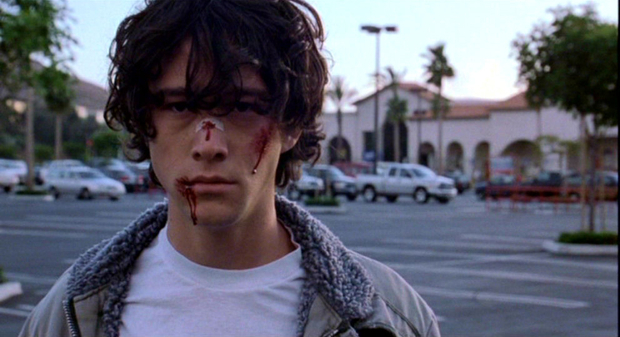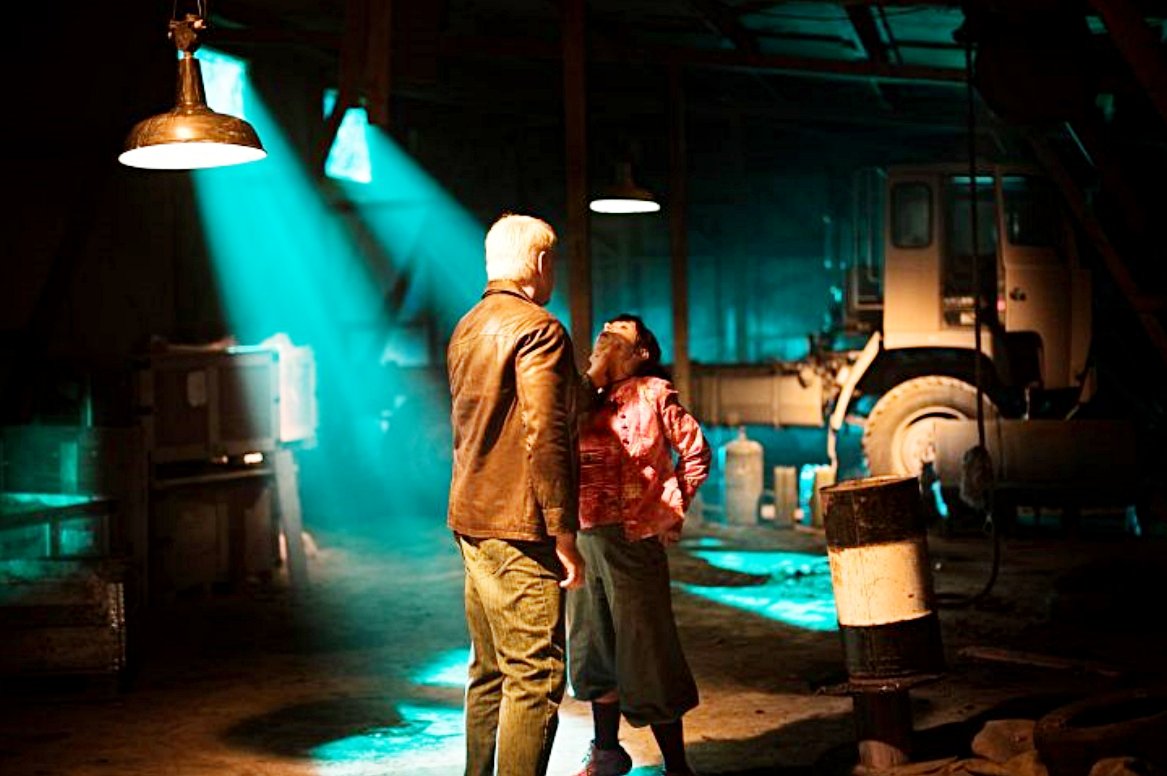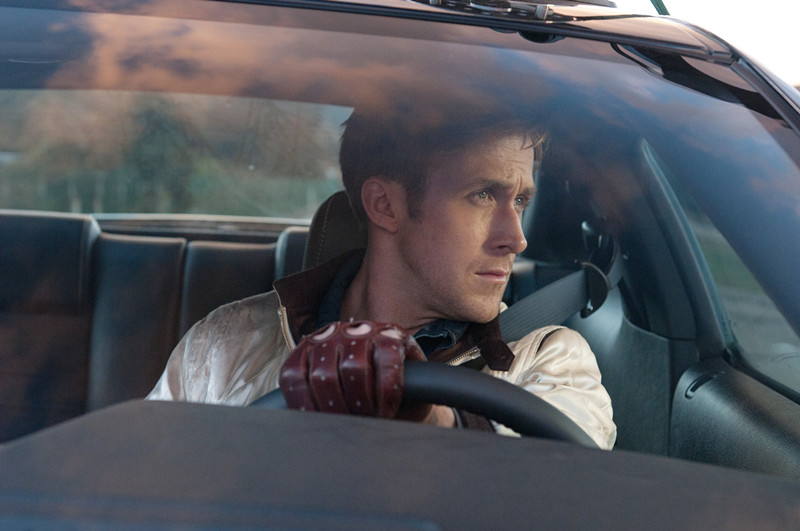21. Seven (David Fincher, 1995)
Screenplay by Andrew Kevin Walker
Seven is a perfect example of a screenwriter’s vision making it to the screen and the result is a dark classic about a pair of detectives searching for a murderer whose grotesque crimes are inspired by the seven deadly sins of Christianity.
While co-star Brad Pitt’s performance may be mediocre, Morgan Freeman’s screen presence and subtle power are undeniable in one of the revered actor’s best performances.
Screenwriter Walker’s work would get far less favorable treatment courtesy of Joel Schumacher’s rewrites on 1999’s 8MM. Seven’s incredibly atmospheric cinematography by Darius Khondji was highly influential.
22. Insomnia (Erik Skjoldbjaerg, 1997)
Screenplay by Skjoldbjaerg and Nikolaj Frobenius
Easily eclipsing the softened American remake directed by Christopher Nolan in 2002, the original Insomnia features a fabulous performance by international screen actor Stellan Skarsgard as a corrupt cop stricken with the malady of the film’s title who becomes involved in an unusual relationship with a murderer.
Films that have become known as “Scandinavian Noir” or “Nordic Noir” are well known today in the wake of the success of The Girl with the Dragon Tattoo trilogy (2009) and Morten Tyldum’s Headhunters (2011) but this was not the case in 1997.
Insomnia, set apart by the fact it was not adapted from a novel as most films in the Scandinavian Noir category are, is an absolute must-see for anyone interested in the dark crime films from that part of world or neo-noir films in general.
23. The Crimson Rivers (Mathieu Kassovitz, 2000)
Screenplay by Kassovitz based on the Jean-Christophe Grange novel
Vincent Cassel and Jean Reno play a pair of detectives investigating a series of murders in an isolated university town in this highly atmospheric French film that culminates in a tense mountainside climax.
Cassel and Reno make a great acting team, the murders-seen in aftermath-recall the best of Italian giallo and the cinematography by Thierry Arbogast is superlative. Arbogast frequently works with director Luc Besson and had previously shot Besson’s Leon: The Professional.
A very poor sequel to Crimson Rivers was made in 2004, starring Reno but not Cassel.
24. Sexy Beast (Jonathan Glazer, 2000)
Screenplay by Louis Mellis and David Scinto
Ray Winstone stars as a retired British gangster named Gal who now resides in Spain with his wife. His past explodes into his present as his old colleague Don shows up unexpectedly and tries to recruit Gal for an ambitious bank robbery back in England.
Ben Kingsley’s Academy Award-nominated performance as the vicious Don Logan is a sight to behold and Ray Winstone is always solid but Sexy Beast also features a great supporting performance by veteran actor Ian McShane as crime boss Teddy Bass.
The film could do without the brief, superfluous fantasy sequences that occur at several points in Sexy Beast but the film is must-see for fans of British crime cinema and contemporary neo-noir.
Ray Winstone and Ian McShane reunited with Sexy Beast screenwriters Mellis and Scinto in 2009 for Malcolm Venville’s very disappointing revenge film 44 Inch Chest, which comes off more as a stage play than dynamic crime cinema.
25. The Aura (Fabian Bielinsky, 2005)
Screenplay by Bielinsky
An epileptic taxidermist who believes he has an infallible photographic memory gets tangled up in a robbery plot in the severely overlooked The Aura.
Having starred in screenwriter/director Bielinsky’s clever but decidedly lighter crime film Nine Queens (2000), the great Argentinian actor Ricardo Darin plays the lead here in one of the best performances of his highly accomplished career.
Bielinsky’s untimely death in 2006 robbed the cinematic world of a very talented individual and a director/actor collaboration that had incredible potential.
What Daniel Auteuil is to French cinema and Javier Bardem is to Spanish cinema, Ricardo Darin is to Argentinian cinema. Be sure to catch his outstanding performances in Juan Jose Campanella’s Academy Award winning The Secret in Their Eyes (2009) and Pablo Trapero’s underrated neo-film noir Carancho (2010).
26. Brick (Rian Johnson, 2005)
Screenplay by Johnson
A high school loner played by Joseph Gordon-Levitt investigates the murder of his ex-girlfriend in this unique film modeled after classic hard-boiled detective films.
In less talented hands Brick, with its “old meets new” storyline and unique slang, could have gone way off course but the film works very well and is anchored by a superb lead performance by Gordon-Levitt.
Screenwriter/director Johnson went through a sophomore slump with the offbeat con-man film The Brothers Bloom (2008) then cast Gordon-Levitt as the lead in his clever but very uneven time-travel crime film Looper (2012).
27. A History of Violence (David Cronenberg, 2005)
Screenplay by Josh Olson based on the John Wagner and Vince Locke graphic novel
A small-town diner owner draws the attention of some big city criminals after thwarting a robbery attempt.
Viggo Mortensen delivers a solid performance as the diner owner and Maria Bello is excellent as his wife. Actors Stephen McHattie, Greg Bryk and Ed Harris shine as three of the film’s deadly villains.
The miscast William Hurt-the only actor in the film who delivers a weak performance-was inexplicably nominated for an Academy Award for Best Supporting Actor for his brief role in the film when that accolade should have gone to Ed Harris.
One of the other problems with A History of Violence is the rapid cutting of the fight scenes in the film that rob those few pivotal sequences of their intended power.
Cronenberg would re-team with Mortensen for another neo-film noir in 2007’s Eastern Promises and show the world he had solved his fight scene directing issues by creating one of the most brutal, intense and effective hand-to-hand combat scenes ever put on film.
The aforementioned issues aside, A History of Violence is very memorable must-see.
28. The Girl With The Dragon Tattoo (Niels Arden Oplev, 2009)
Screenplay by Nikolaj Arcel and Rasmus Heisterberg based on the Steig Larsson novel
The Girl Who Played With Fire (Daniel Alfredson, 2009)
Screenplay by Jonas Frykberg based on the Steig Larsson novel
I’ve included both films in one write-up since they are the first two parts of one long story about a brilliant computer hacker and an investigative journalist who uncover deadly secrets about a wealthy family.
Much has been written and discussed regarding these Swedish films and the completely unnecessary American remake of the first film by David Fincher in 2011.
The engine that really makes these films work is the incredible lead performance by Noomi Rapace as Lisbeth Salander that the remake proves was inimitable.
The third entry in the 2009 series The Girl Who Kicked the Hornet’s Nest is both the least visceral and the least memorable of the trilogy.
29. Drive (Nicolas Winding Refn, 2011)
Screenplay by Hossein Amini based on the James Sallis novel
Ryan Gosling delivers a great lead performance as an “actions speak louder than words” getaway driver who tries to survive in the wake of a robbery gone wrong.
Director Refn opts for a vicious and bloody portrayal of violence in this superb film that also features Albert Brooks in the role of his career as a film producer turned criminal.
Drive exists in the same narrative world as Walter Hill’s The Driver (1978) but is by far the better film.
30. Cold in July (Jim Mickle, 2014)
Screenplay by Mickle & Nick Damici based on the Joe R. Lansdale novel
Michael C. Hall, Sam Shepard and Don Johnson star as a trio whose paths cross in the aftermath of a deadly crime in Mickle and Damici’s fourth film together.
All of Mickle and Damici’s films center on family relationships and this preoccupation is at the core of Cold in July as the search for a lost son that was presumed dead takes center stage.
An excellent recent addition to the world of neo-film noir, Cold in July is must-see.
Author Bio: Terek Puckett is an actor, screenwriter and film writer based in Los Angeles. He is a graduate of Wright State University in Ohio and his areas of film expertise include horror cinema and neo-film noir. More of his film writing can be seen here: http://www.soundonsight.org/author/terek-puckett/.










